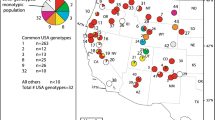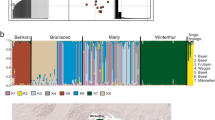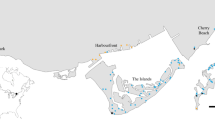Abstract
As dominant herbivores and notorious pests in their native Neotropics, introduced leaf-cutting ants have the potential for ecological and economic harm. Although a large-scale invasion of leaf-cutting ants has not occurred, an isolated introduction in the Caribbean islands of Guadeloupe provides useful insight into the progress of such an invasion. Since being first detected in 1954, Acromyrmex octospinosus has colonized virtually all available land area, defying an aggressive control campaign and damaging agriculture. I attempted to reconstruct the origins and spread of the invasion, as well as screen for the presence of garden pathogens, which could be used for biological control. Mitochondrial sequencing of the A. octospinosus complex throughout the Caribbean showed that the probable source of the invasion lies on Trinidad and Tobago or northeast South America. Using historical records and field surveys, the invasion’s rate of spread was estimated at 0.51 km/year. Microsatellite genotyping further confirmed the limited dispersal abilities of A. octospinosus, showing the presence of isolation by distance (even in a relatively small geographic area) and suggested ubiquitous local inbreeding. Although the invasion likely resulted from the introduction of a single colony, microsatellites showed a high level of genetic variation in the introduced population, likely as a consequence of multiple mating by the queen. A survey showed that the specialized fungus garden pathogen Escovopsis exists on the islands, suggesting that the successful spread of the ants was not due to escape from this parasite. Given that chemical control has failed in the past and that biological control using specialized garden pathogens seems improbable, only vigorous quarantine and inspection programs may prevent wide-scale leaf-cutting ant invasions in the future.



Similar content being viewed by others
References
Blanche D (1954) Découverte d’un foyer de fourmis champignonnistes a la Guadeloupe. Bulletin de la Société Française d’Histoire Naturelle des Antilles 4
Cherrett JM (1968) Some aspects of the distribution of pest species of leafcutting ants in the Caribbean. Am Soc Horticult Sci Trop Reg 12:295–310
Christian CE (2001) Consequences of a biological invasion reveal the importance of mutualism for plant communities. Nature (London) 413:635–639
Currie CR (2001) A community of ants, fungi, and bacteria: A multilateral approach to studying symbiosis. Ann Rev Microbiol 55:357–380
Currie CR, Mueller UG, Malloch D (1999a) The agricultural pathology of ant fungus gardens. Proc Nat Acad Sci USA 96:7998–8002
Currie CR, Scott JA, Summerbell RC, Malloch D (1999b) Fungus-growing ants use antibiotic-producing bacteria to control garden parasites. Nature 398:701–704
Currie CR, Bot ANM, Boomsma JJ (2003a) Experimental evidence of a tripartite mutualism: bacteria protect ant fungus gardens from specialized parasites. Oikos 101:91–102
Currie CR, Wong B, Stuart AE, Schultz TR, Rehner SA, Mueller UG, Sung GH, Spatafora JW, Straus NA (2003b) Ancient tripartite coevolution in the attine ant-microbe symbiosis. Science 299:386–388
Currie CR, Poulsen M, Mendenhall J, Boomsma JJ, Billen J (2006) Coevolved crypts and exocrine glands support mutualistic bacteria in fungus-growing ants. Science 311:81–83
Excoffier L, Laval G, Schneider S (2005) Arlequin (version 3.0): an integrated software package for population genetics data analysis. Evol Bioinform Online 1:47–50
Febvay G, Hostachy B, Rahbe Y, Kermarrec A (1988) Principes d’une nouvelle strategie de lutte contre la fourmi-manioc, Acromyrmex octospinosus Reich, en Guadeloupe. Bulletin Agronomique (Petit-Bourg) 7:10–15
Gomel L, Febvay G, Madignier Ml, Kermarrec A (1989) Une situation préoccupante en Guadeloupe: la fourmi-manioc met les bouchees doubles. Phytoma 410:10–15
Hölldobler B, Wilson EO (1990) The ants. Harvard University Press, Cambridge, MA
Holway DA, Suarez AV, Case TJ (1998) Loss of intraspecific aggression in the success of a widespread invasive social insect. Science 282:949–952
Keane RM, Crawley MJ (2002) Exotic plant invasions and the enemy release hypothesis. Trends Ecol Evol 17:164–170
Kermarrec A, Mauleon H (1990) Psychotropic substances imparing the vigilance of Acromyrmex octospinosus Reich (Attini, Formicidae). In: Vander Meer RK, Jaffe K, Cedeno A (eds) Applied myrmecology, a world perspective. Westview Press, Boulder, CO, pp 645–662, 741 pp
Krieger MJB, Keller L (2000) Mating frequency and genetic structure of the Argentine ant Linepithema humile. Mol Ecol 9:119–126
Malato G, Kermarrec A, Troup JM (1977) Donnes nouvelles sur l’invasion de la Guadeloupe par Acromyrmex octospinosus Reich (Formicidae, Attini). I. Aspects biogeografiques et perspectives de controle chimique. Nouvelles Agronomiques Antilles-Guyane 3:473–484
McGlynn TP (1999a) Non-native ants are smaller than related native ants. Am Nat 154:690–699
McGlynn TP (1999b) The worldwide transfer of ants: geographical distribution and ecological invasions. J Biogeogr 26:535–548
Mikheyev AS, Mueller UG (2006) Invasive species: customs intercepts reveal what makes a good ant stowaway. Curr Biol 16:129–131
Mikheyev AS, Mueller UG, Abbot P (2006) Cryptic sex and many-to-one coevolution in the fungus-growing ant symbiosis. Proc Nat Acad Sci USA 103:10702–10706
Mikheyev AS, Mueller UG (2007) Genetic relationships between native and introduced populations of the little fire ant Wasmannia auropunctata. Divers Distrib, doi:10.1111/j.1472-4642.2007.00370.x
Mikheyev AS, Mueller UG and Boomsma JJ (2007) Population genetic signatures of diffuse co-evolution between leaf-cutting ants and their cultivar fungi. Mol Ecol 16(1):209–216
Mitchell CE, Power AG (2003) Release of invasive plants from fungal and viral pathogens. Nature (London) 421:625–627
Murakami T, Higashi S, Windsor D (2000) Mating frequency, colony size, polyethism and sex ratio in fungus-growing ants (Attini). Behav Ecol Sociobiol 48:276–284
Ortius-Lechner D, Gertsch PJ, Boomsma JJ (2002) Variable microsatellite loci for the leafcutter ant Acromyrmex echinatior and their applicability to related species. Mol Ecol 9:114–116
Peakall R, Smouse PE (2006) genalex6: genetic analysis in Excel. Population genetic software for teaching and research. Mol Ecol Notes 8:288–295
Poulsen M, Bot ANM, Currie CR, Nielsen MG, Boomsma JJ (2003) Within-colony transmission and the cost of a mutualistic bacterium in the leaf-cutting ant Acromyrmex octospinosus. Funct Ecol 17:260–269
Ross KG, Fletcher DJC (1985) Genetic origin of male diploidy in the fire ant, Solenopsis invicta (Hymenoptera: Formicidae), and its evolutionary significance. Evolution 39:888–903
Ross KG, Vargo EL, Fletcher DJC (1988) Colony genetic structure and queen mating frequency in fire ants of the subgenus Solenopsis (Hymenoptera: Formicidae). Biol J Linnean Soc 34:105–117
Shoemaker DDW, Deheer CJ, Krieger MJB, Ross KG (2006) Population genetics of the invasive fire ant Solenopsis invicta (Hymenoptera: Formicidae) in the United States. Ann Entomol Soc Am 99:1213–1233
Suarez AV, Case TJ (2002) Bottom-up effects on persistence of a specialist predator: Ant invasions and horned lizards. Ecol Appl 12:291–298
Suarez AV, Holway DA, Case TJ (2001) Patterns of spread in biological invasions dominated by long-distance jump dispersal: Insights from Argentine ants. Proc Nat Acad Sci USA 98:1095–1100
Suarez AV, Holway DA, Ward PS (2005) The role of opportunity in the unintentional introduction of nonnative ants. Proc Nat Acad Sci USA 102:17032–17035
Sumner S, Aanen DK, Delabie JC, Boomsma JJ (2004) The evolution of social parasitism in Acromyrmex leaf-cutting ants: a test of Emery’s rule. Insectes Sociaux 51:37–42
Therrien P (1986) Behavioral ecology of the leaf-cutting ant, Acromyrmex octospinosus (Reich), in Guadeloupe, F.W.I., Ph.D. dissert., University of British Columbia, Canada, 166 pp
Tsutsui ND, Suarez AV, Holway DA, Case TJ (2000) Reduced genetic variation and the success of an invasive species. Proc Nat Acad Sci 97:5948–5959
Weber NA (1972) Gardening ants, the attines. Memoirs of the American Philosophical Society, Philadelphia, xvii+146 pp
Wetterer JK, Gruner DS, Lopez JE (1998) Foraging and nesting ecology of Acromyrmex octospinosus (Hymenoptera: Formicidae) in a Costa Rican tropical dry forest. Fla Entomol 81:61–67
Wheeler WM (1907) The fungus-growing ants of North America. Bull Am Mus Nat Hist 23:669–807
Wirth R, Beyschlag W, Ryel R, Herz H, Hölldobler B (2003) The herbivory of leaf-cutting ants. A case study on Atta colombica in the tropical rainforest of Panama. Springer Verlag, Berlin
Acknowledgments
I am extremely grateful to Wetterer and Schultz for providing material without which the phylogeographic analysis would have been impossible. I thank Gerardo for help advice on how to collect Escovopsis and, along with Taerum, for help in identifying Escovopsis. Scott and Abbott provided valuable advice for the molecular analyses. I would like to thank Solomon, Scott, Economo and Rabeling for their companionship and help during our travels through the Caribbean. I am also grateful to Solomon and Schmidt for reading and substantially improving the manuscript through their comments. The manuscript has benefited from the excellent comments of two anonymous reviewers. Last but not least, I would like to thank my Ph.D. advisor UG Mueller for permitting me the freedom carry out this work in his lab and for generously allowing the use of funds from his NSF CAREER grant (DEB-9983879). Additional funding for this research has been funded by a fellowship from the US EPA and research grants from the University of Texas section of Ecology, Evolution and Behavior, as well as from a NSF Dissertation Improvement Grant (DEB-0508613).
Author information
Authors and Affiliations
Corresponding author
Rights and permissions
About this article
Cite this article
Mikheyev, A.S. History, genetics and pathology of a leaf-cutting ant introduction: a case study of the Guadeloupe invasion. Biol Invasions 10, 467–473 (2008). https://doi.org/10.1007/s10530-007-9144-7
Received:
Accepted:
Published:
Issue Date:
DOI: https://doi.org/10.1007/s10530-007-9144-7




